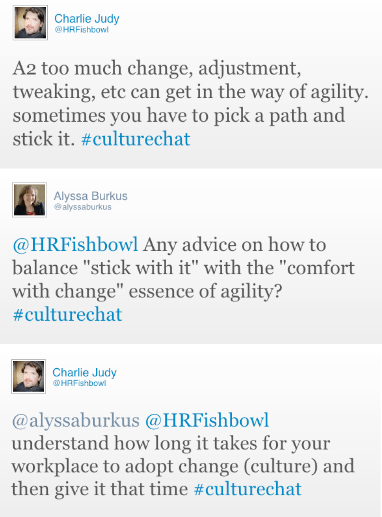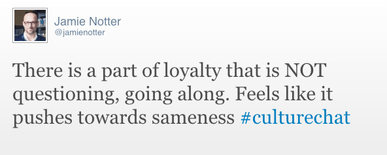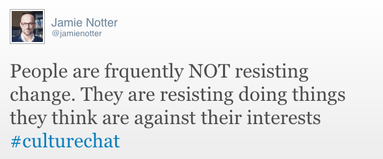- A well articulated mission, one that inspires, sets tones and goals.
- Embracing voices of disagreement as alternate perspectives that could improve results.
- Humor cannot be discounted. If people are laughing, that creates a willingness to risk.
- Willingness to get things wrong, make mistakes, take some risks.
- Organizational fit-members of the team have to be compatible/right fit.
- Willingness to confront each other without taking things personally.
- Creativity/allowing people to find new ways to work.
- Don’t let perfection get in the way of progress. Or great in the way of good.
- Great ideas can come from anywhere, anyone and at any level.
- Transparency at the top, which breeds trust in the organization.
- Awareness-being in tune with landscape, influencing factors.
- Fast decision making & rapid course correction.
- Autonomy-allowing people to make decisions and take action.
NimbleUser’s TakeThese are great answers and all very true! At NimbleUser, the one that stands out is embracing conflict and disagreement. In fact, we sometimes appoint a “devil’s advocate” in the room to poke holes in an idea or plan. By making it an official role, it allows us to respectfully push and question each other and ultimately makes the idea or plan stronger. The above list is really on target with the type of culture NimbleUser strives for.
Q2: What makes it hard to be nimble?
- Pride in ownership, territorialism, silos.
- Not having a system of “test” or “pilot”-every effort being a full commitment at step 1.
- People needing to be in control or charge.
- Unclear expectations.
- Telling someone “how” to do something versus explaining the desired end result.
- Thinking you already have all of the answers, figured it out, and there is no room for improvement.
- Too much change, adjustment, tweaking, etc. can get in the way of agility. Sometimes you have to pick a path and stick it.
- Lack of decision-making ability. To be nimble you have to make decisions, not please everyone.
NimbleUser’s TakeThe change comment is a hot topic for most organizations. At NimbleUser, we have a saying that “change is the only constant.” Part of that saying puts people at ease. It says that change and #ContinuousImprovement (value #3) are in our DNA and ironically, change becomes the predictable factor. We anticipate that things WILL change. The market changes, information changes and we must be willing to adjust our course. This type of environment also allows us to experiment, take risks and innovate. After all, if an effort doesn’t produce the expected outcome, we will change course and try again.
I particularly enjoyed this Twitter exchange which talks about change and understanding how and how long it takes your culture to process change.
- Roles, responsibilities, authorities should be defined but not static. They can shift as necessary.
- Leaders need to know how to “clear the decks” so teams can move forward rapidly.
- Hire people who are comfortable with ambiguity and willingness to take direction from any number of people (right people).
- Jamie mentions ownership vs loyalty and here is why:
The loyalty vs. ownership comment is very interesting. In a high performing organization, you want “owners” on your team. You want the type of people who will take things and run with them. In Jamie’s tweet he mentions loyalty as almost a blind following. While you could argue that loyalty is important in it’s own right (loyal employees act and behave as if it were their own company-making good decisions and acting in the best interest of the company), loyalty, at times, can hold us back. Because you have a longtime relationship with a co-worker or teammate you might have a harder time holding them accountable or pushing back on an idea or plan. We would agree that ownership is important to measuring success and for personal accountability. However, loyalty is not to be discounted.
Q4: We can’t be nimble because people resist change. Discuss.
- Change should be the outcome, not the process.
- “Perpetual Beta” can be a great mindset to embrace.
- “Perpetual Beta” can be thought of as “freedom from perfection paralysis.”
The world is made up of risk-takers and risk averse people. Let’s face it–we all have different degrees of comfort with change. It is in these different reactions to change where people learn and grow the most. The risk taker may learn best by making too bold of a move, whereas the risk averse person may learn from a missed opportunity. The risk taker may encourage immediate action whereas a risk averse person may “pump the brakes” and ask more questions. A well balanced team will encourage the viewpoints of both of these people and embrace these qualities in the decision-making process. It helps to remind the team that the common ground found between these two very different type of people is the motivation to do what’s in the best interest of the organization.
Culture is Ever Evolving
The questions that Jamie Notter asked are very on-point and things that culture-conscience organizations think about. At NimbleUser we are having daily conversations about what it means to be agile and nimble. Having these conversations regularly helps to ensure that these topics are top of mind for everyone and part of the culture.






